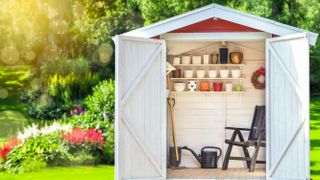How to waterproof your shed — expert tips for winter protection
Keep your shed dry this winter

With winter weather setting in, protecting your garden shed from water damage becomes crucial. While you might already know ways to winterize your pipes and how to protect your garden hose from freezing temperatures, your shed needs attention too.
Experts at Garden Buildings Direct warn that neglect could lead to costly repairs or even replacement. Damp, rot, and structural issues can quickly turn your sturdy shed into a sorry sight. Spending time on preventative maintenance now is a small investment that can save hundreds in repairs and protect your garden shed for years to come.
Just as there are tried and tested ways to winterize your home and save money on your energy bills, these expert-recommended steps will help keep your outdoor structure dry and damage-free through the wet months ahead. Here's how to protect your shed, summer house, or outdoor office this winter.
And while you are protecting your shed, you might also want to secure your shed from break-ins.
1. Start with a solid foundation

Ensure your shed sits on a proper base, elevated from ground contact. While a sturdy wooden base works for smaller structures, larger sheds might need concrete foundations to prevent rising damp and insect damage.
2. Check windows and doors

Inspect frames carefully as wood can shrink over time, creating cracks that let water seep in. Fill any gaps you find immediately, and check the wood for signs of rot.
If you discover soft, rotted patches, remove the damaged wood and repair with wood filler. Regular maintenance of these vulnerable points is essential for keeping your shed waterproof.
Get professional-looking wood repairs without the professional price tag. This complete kit includes wood filler that dries quickly, takes stain well, and resists shrinking. Comes with everything needed — putty knife and sanding block included.
3. Inspect your roof

Pay special attention to roofing felt or shingles, particularly at edges and ridge lines. Look for deterioration where materials are nailed down and patch any vulnerable areas immediately.
4. Maintain proper drainage

Clear gutters of leaves and debris to prevent water backup. Consider installing gutters if you don't have them — the runoff water can be collected in a water butt and in turn used to water your garden.
5. Ensure good airflow

Install static vents on opposite sides of your shed for proper ventilation. Add to keep insects out, consider adding a bug-proof mesh that will also maintain airflow.
This versatile pack of fine mesh screens is perfect for repair jobs and DIY projects. Each sheet is made from durable stainless steel that won't rust or corrode. Ideal for fixing window screens, creating strainers, or protecting your garden shed from insects. At this price, it's worth keeping a pack in your toolbox.
6. Apply preservative annually

Protect against weather damage, rot, mould, and algae with regular wood preservative treatment. Choose the right product for your needs and make application an annual routine.
Now you know how to protect your shed, consider tackling other winter preparation tasks around your property. Whether you're wondering if you should repair or replace your HVAC unit, looking for ways to ventilate a room without windows, or ready to learn why fall is the best time to prep your lawn, getting ahead of winter maintenance will save you time and money in the long run.
Sign up to get the BEST of Tom's Guide direct to your inbox.
Get instant access to breaking news, the hottest reviews, great deals and helpful tips.

Kaycee is an Editor at Tom’s Guide and has been writing for as long as she can remember. Her journey into the tech world began as Cazoo's Knowledge Content Specialist, igniting her enthusiasm for technology. When she’s not exploring the latest gadgets and innovations, Kaycee can be found immersed in her favorite video games, or penning her second poetry collection.

